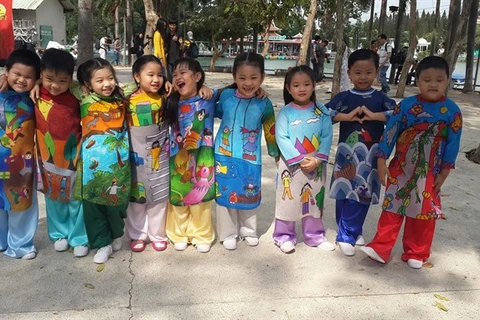Hanoi (VNA) – The influx of foreign fast fashion brands into Vietnam is threatening local retailers’ market share, forcing the firms to move to keep their foothold in the market, Dau tu (Vietnam Investment Review) newspaper reported.
Le Thi Quynh Trang, General Director of the Multimedia JSC – which runs many fashion programmes in Vietnam, said the country is becoming more popular in the global fashion industry as most fashion brands, from high-end to fast fashion ones like Chanel, Giovanni, Salvatore Ferragamo, Versace, Burberry, Topshop, Mango and Zara, have come to Vietnam. H&M and Uniqlo also plan to enter this market.
“Vietnamese consumers’ demand is now ripe for them to make inroads into Vietnam,” she said.
H&M is scheduled to open its first outlet in Ho Chi Minh City in the next few days. The Swedish brand said Vietnam is one of its five key future markets.
There are nearly 200 foreign fashion brands in Vietnam, accounting for more than 60 percent of the market share. Mid-end brands like Giordano and Bossini and high-end ones such as Mango, Dolce & Gabbana, Topshop, Gap, Banana Republic and Tommy Hilfiger post the strongest sales.
Competition pressure
Foci, a domestic brand that debuted in 1999 and gained a strong foothold in the affordable segment, folded in 2014.
Ngo Thi Bau, General Director of Nguyen Tam Textile & Garment Company – Foci’s owner – switched to opening a Japanese-style restaurant chain in HCM City. She said aside from high ground rent, Foci had to give up due to falling sales caused by cheap clothing from China and counterfeits.
The Viet Fashion Joint Stock Company, which owns Ninomaxx and N&M brands, has been making strategic steps to develop. It has 62 retail outlets across the country at present and plans to increase store numbers soon.
However, some insiders said Ninomaxx may lose its status to foreign rivals. They said in addition to cost-related problems, Vietnamese firms struggled as they were unable to grasp the latest fashion trends or change their promotion methods.
Zara earned 5.5 billion VND (nearly 242,000 USD) on the opening day of its outlet at Vincom Dong Khoi shopping mall in HCM City on September 8, 2016. That reflects Vietnamese consumers’ interest in foreign fast fashion, which pressures domestic brands to make changes, according to Dau tu newspaper.
The force to change
Among Vietnamese brands, Canifa has emerged as an affordable fashion brand with the leading growth rate and store number in the country. The presence of Zara, H&M and Uniqlo has forced Canifa to change, especially with their target markets similar.
Canifa has raised the number of its outlets to 96, many of which are based in major shopping malls or ideal locations in big provinces and cities. An advantage of this firm is that its factories are in Vietnam, helping cut time from design, production to sale.
Nguyen Van Thoi, Chairman of TNG Investment and Trading Joint Stock Company, said the entrance into Vietnam by H&M, Zara and Uniqlo is a chance for Vietnamese brands to develop their designs but also a big challenge.
TNG used to manufacture apparel ordered by Walmart, Zara, Levi’s, GAP, CK and Puma. However, it decided to abandon this and specialise in selling TNG-branded products. TNG outlets are expected to increase to about 100 this year, he said.
The decisive factor is keeping up with consumers’ taste, thus Vietnamese firms need professional designers. TNG has partly satisfied the market’s demand and gained a market share, he noted.
Thoi said TNG products are sold at competitive prices and will outpace foreign brands in this regard.-VNA
VNA

























